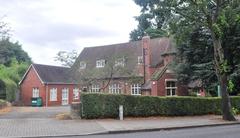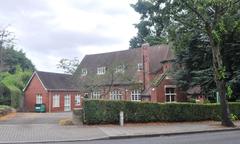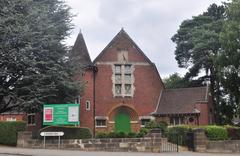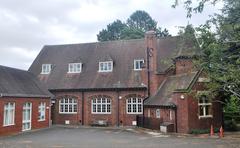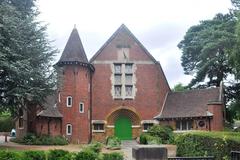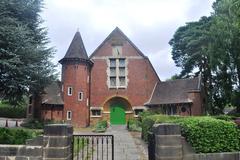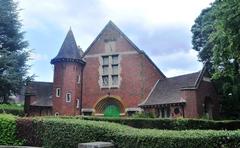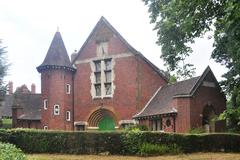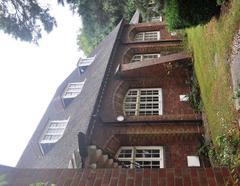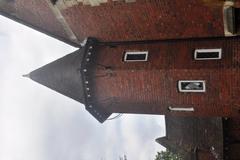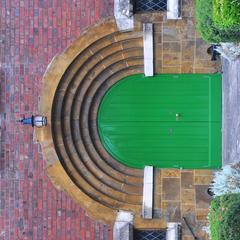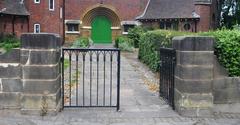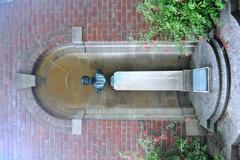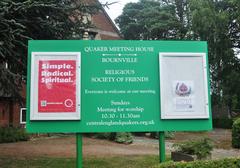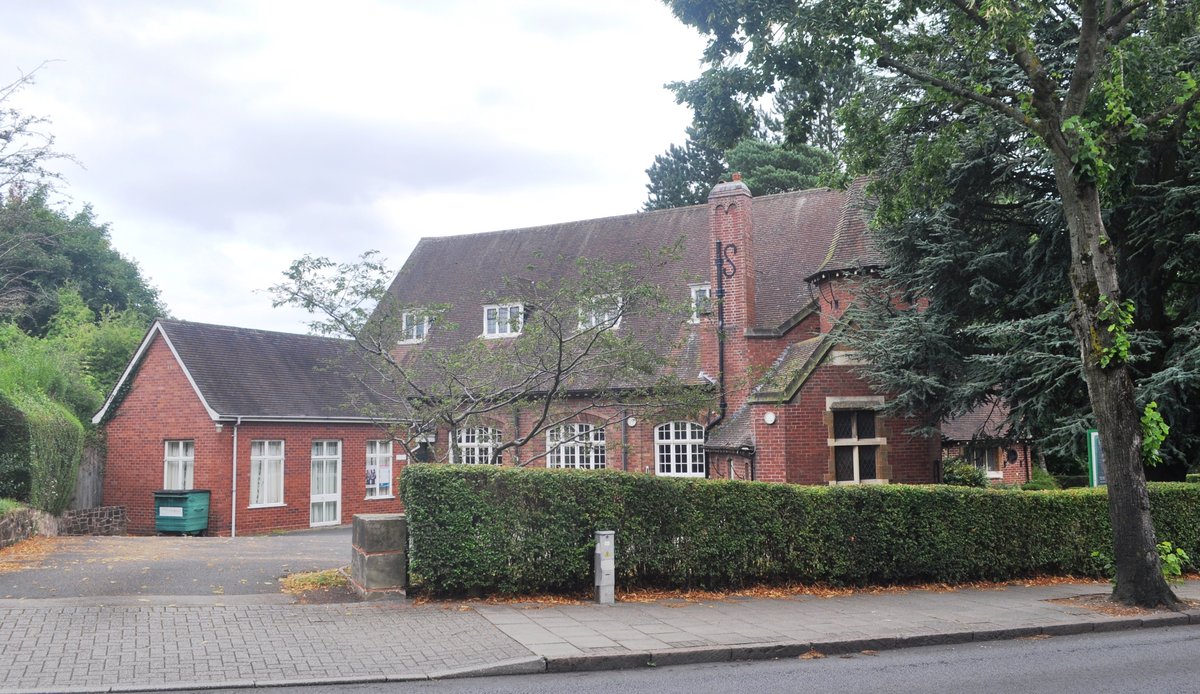
Friends Meeting House Birmingham: Visiting Hours, Tickets, and Historical Significance
Date: 14/06/2025
Introduction
Nestled in the vibrant heart of Birmingham, United Kingdom, Friends’ Meeting Houses stand as enduring symbols of the Religious Society of Friends’ (Quakers) commitment to peace, simplicity, and community. From the historic Bull Street Meeting House in the city centre, to the tranquil Selly Oak site with its Cadbury family legacy, and the Kings Heath Meeting House’s community focus, these venues offer unique windows into over three centuries of Quaker worship and social engagement. This comprehensive guide provides everything you need—visiting hours, ticketing, accessibility, historical insights, and travel tips—to make the most of your exploration of Birmingham’s Quaker heritage. For the latest updates and additional details, consult official resources such as the Bull Street Quaker Meeting, Heritage Quaker reports, and the Birmingham Quakers website.
Table of Contents
- Bull Street Meeting House Birmingham: Visitor’s Guide
- Friends’ Meeting House Selly Oak: History and Visitor Information
- Friends’ Meeting House Kings Heath: Worship, Community, and Practical Details
- Summary and Further Resources
- References
Bull Street Meeting House Birmingham: Visitor’s Guide
Early Quaker Presence in Birmingham
Quaker activity in Birmingham dates back to the 1650s, when Friends met discreetly in private homes due to prevailing religious restrictions (The Iron Room). The passage of the Toleration Act in 1689 enabled Friends to legally register places of worship. That same year, Quakers established their first formal meeting site and burial ground in Colmore’s Lane (now Colmore Row), laying the foundation for an enduring Quaker presence (Bull Street Quaker Meeting History, Heritage Quaker PDF).
Evolution of the Bull Street Meeting House
1703–1857: In 1703, Birmingham’s first purpose-built Quaker Meeting House opened on Bull Street. As the city’s population and the congregation flourished, the building underwent several expansions, including significant modifications in the 18th and 19th centuries to address urban noise and accommodate more worshippers. By 1857, a new, larger Meeting House was constructed to serve the growing community (Heritage Quaker PDF).
1931–Present: The current Bull Street Meeting House, designed by Hubert Lidbetter, was built between 1931 and 1933. This two-storey structure, with its five-bay facade and open porch, balances Quaker simplicity with practical needs for urban worship and community engagement (Heritage Quaker PDF).
Visiting Information
- Address: 40 Bull Street, Birmingham, B4 6AF (Bull Street Quaker Meeting)
- Visiting Hours:
- Monday to Friday: 9:00 AM – 5:00 PM
- Sunday Worship: 10:30 AM – 11:30 AM
- Saturday: Closed
- Admission: Free; no tickets required. Donations are welcome but optional.
- Accessibility: Step-free entrance, wheelchair access throughout, and hearing loops in main spaces. Contact in advance for specific needs.
- Guided Tours: Available by prior arrangement for groups and educational visits.
- Facilities: Accessible restrooms; nearby cafés and restaurants; no on-site childcare or café.
Nearby Attractions and Travel Tips
- Public Transport: Steps from Bull Street tram stop; 10-minute walk from Birmingham New Street Station; multiple bus routes nearby.
- Parking: Limited street parking; public car parks in the vicinity.
- Local Sights: Birmingham Museum & Art Gallery, Victoria Square, Jewellery Quarter, Birmingham Cathedral, Great Western Arcade.
- Visitor Tips: Arrive early for worship, dress modestly, and maintain a quiet, respectful demeanor.
Architectural and Heritage Significance
The Bull Street Meeting House is a living testament to Quaker architectural values—plain yet elegant, focused on communal gathering. Its evolution mirrors Birmingham’s urban growth and the resilience of the city’s Quaker community (Quakers in Britain). The site’s continuous use and adaptation over centuries enhance its heritage and archaeological value (Heritage Quaker PDF).
FAQ
Q: What are the visiting hours?
A: Monday–Friday, 9:00 AM–5:00 PM; Sunday worship at 10:30 AM.
Q: Is admission free?
A: Yes, no tickets required.
Q: Is the building accessible?
A: Fully wheelchair accessible with hearing loops. Contact for additional needs.
Q: Are guided tours available?
A: Yes, by appointment for groups.
Q: Can I take photographs?
A: Allowed outside worship times; avoid flash and respect privacy.
Friends’ Meeting House Selly Oak: History and Visitor Information
Historical and Architectural Context
Built in 1926–27 as a philanthropic gift from Edward Cadbury, the Selly Oak Meeting House exemplifies domestic Neo-Georgian style—plain, functional, and closely aligned with Quaker values (heritage.quaker.org.uk). Its location, set back from Bristol Road in a peaceful, landscaped environment, reflects the Quaker preference for tranquility.
Community Use and Accessibility
- Primary Use: Quaker worship and extensive community events.
- Facilities: Three meeting rooms, kitchen, accessible WC; level access throughout; hearing loop.
- Access: No fixed public hours—open during community sessions or by appointment. Guided tours can be arranged (official heritage report).
- Transport: Bus routes 11, 61, 63; half a mile from Selly Oak railway station; on-site car/bicycle parking.
Significance
Closely linked to the Bournville Village Trust and the Cadbury family, the Selly Oak Meeting House embodies both the Quaker tradition and Birmingham’s history of social reform. It is valued for its communal role as well as its historic and associative significance (heritage.quaker.org.uk).
FAQ
Q: Is there an entry fee?
A: No, but room hire for events may incur a charge.
Q: Is the building accessible?
A: Yes, with level access and accessible toilets.
Q: Is parking available?
A: Yes, on-site car and bicycle parking.
Friends’ Meeting House Kings Heath: Worship, Community, and Practical Details
Location and Setting
Located in the dynamic Kings Heath area, the Friends’ Meeting House (Friends’ Institute) was established in 1899, funded by Richard Cadbury (Heritage Quaker). Easily reached by public transport, it sits among other cultural landmarks.
Features and Atmosphere
Designed for simplicity and community, the Meeting House includes a coffee room, reading room, lecture hall, and a plain worship space, all fostering inclusivity and reflection.
Worship and Community Life
- Meeting for Worship: Sundays (see Birmingham Quakers website for current times). Free, open to all.
- Practices: Unprogrammed silent worship; all visitors welcome to participate.
- Events: Lectures, workshops, social action projects, and educational visits available by arrangement (Heritage Quaker).
Practical Visitor Details
- Accessibility: Step-free entry, accessible toilets.
- Parking: Limited; public transport recommended.
- Facilities: On-site toilets, occasional refreshments, small library/bookstore.
- Visitor Etiquette: Silence during worship, modest attire, respectful participation.
FAQ
Q: Can non-Quakers attend worship?
A: Yes, all are welcome.
Q: Are tours available?
A: By appointment; contact the Meeting House.
Q: Is the building accessible?
A: Generally, yes—step-free access and accessible restrooms.
Summary and Further Resources
Visiting Birmingham’s Friends’ Meeting Houses offers a unique journey into Quaker heritage, spirituality, and a tradition of community service that has helped shape the city’s cultural landscape. Each site—Bull Street, Selly Oak, Kings Heath—invites exploration of their historical architecture, peaceful worship, and vibrant community life. With free admission, welcoming ethos, and accessible facilities, these Meeting Houses are invaluable stops for history enthusiasts, spiritual seekers, and anyone interested in Birmingham’s diverse heritage.
Combine your visit with other nearby attractions, such as the Birmingham Museum & Art Gallery or the Jewellery Quarter, to deepen your experience. For updates on special events, guided tours, and community activities, regularly consult the Bull Street Quaker Meeting, Central England Quakers, and Birmingham Quakers. To enrich your exploration, download the Audiala mobile app and follow related guides and social media updates.
References
- Bull Street Meeting House Birmingham: Visiting Hours, Tickets & Historical Guide, 2025, Bull Street Quaker Meeting (https://bullstreet.quakermeeting.org/)
- Visiting the Friends’ Meeting House in Birmingham: Hours, Tickets, and History, 2025, Heritage Quaker (https://heritage.quaker.org.uk/files/Selly%20Oak%20LM.pdf)
- Visiting the Friends’ Meeting House Birmingham: Hours, History, and Visitor Guide, 2025, Heritage Quaker (https://heritage.quaker.org.uk/files/Kings%20Heath%20LM.pdf)
- Friends’ Meeting House Birmingham: Visiting Hours, History, and Practical Tips for Your Visit, 2025, Bull Street Quaker Meeting (https://bullstreet.quakermeeting.org/)
